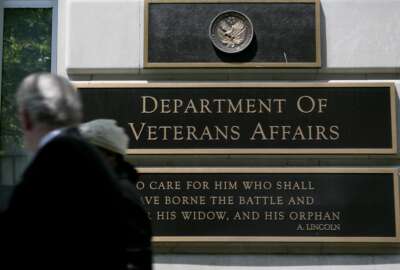Hubbard Radio Washington DC, LLC. All rights reserved. This website is not intended for users located within the European Economic Area.
What does the Veterans Affairs Department do when disaster strikes one of its record-storage facilities?
In July 1973, a fire damaged or destroyed up to 18 million Army and Air Force official military personnel files at the National Archives and Records Administrat...
In July 1973, a fire damaged or destroyed up to 18 million Army and Air Force official military personnel files at the National Archives and Records Administration’s National Personnel Records Center in St. Louis. These records are important for veterans who are looking to make claims with the Veterans Affairs Department. So how did the government do in helping those whose records were lost or damaged in the fire? The VA’s Office of Inspector General looked to answer that question with a recent audit. To learn what it found, the Federal Drive with Tom Temin Executive Producer Eric White talked with Brent Arronte, Deputy Assistant Inspector General for Audits and Evaluations with the VA OIG.
Interview Transcript:
Eric White All right. So lay out exactly what happened at this facility. How many of these records were actually affected. I know that, you know, there is a general number of 18 million, but what did that include?
Brent Arronte So the reason it’s estimated that it was 18 million was that records facility at the time did not actually record the physical location of all of these records. So they’re not 100% sure of all the records that were damaged or destroyed. It’s estimated that those that served in the Army from November 1912 to January 1960, about 80% of those records were lost or destroyed. And those in the Air Force that were discharged between September 25th, 1947 and January 1st, 1964, approximately 75% of those records were destroyed as well.
Eric White Wow. Okay. So this might sound like a weird question. And obviously, this is an important undertaking for the VA OIG. They would like to know, but why now? Why did the IG take a look into what happened in this process now?
Brent Arronte So last year, Representative Carbajal from California through the National Defense Authorization Act of 2023, reached out to the IG and asked if we could conduct a review on this process and to see if the Veterans Benefits Administration was actually helping veterans obtain or reconstruct some of those destroyed or damaged records.
Eric White Okay, So we’ve gotten the scene set here. What efforts did VA make for those veterans whose records were damaged? And obviously, I imagine some other agencies were involved since it involved NARA and it’s a GSA building.
Brent Arronte Sure. So after the fire, VBA developed several processes to assist veterans in helping with the reconstruction process. One of the things that VBA did is they created a fairly lengthy questionnaire that they would send to veterans whose records were once the veterans filed a claim, and it was determined that those records were part of that fire. Now, this questionnaire would help in the process of reconstructing what the veterans did in military service. And these questionnaires asked certain things like what period of service did you serve in, what branch of service you were in, what units you were assigned to? And importantly, do they have any military records in their possession that they can submit to the NPRC to help them reconstruct their records?
Eric White We’re speaking with Deputy Assistant Inspector General for audits and evaluations at the Veterans Affairs Office of Inspector General Brent Arronte. So is this the standardized process for when records are damaged? You know, not in just in this case. Or was this kind of a special circumstance given the amount of records that were damaged?
Brent Arronte So this was a special circumstance. There are special processes that VBA has created for their claims processors to follow. And that’s part of the problem that we found during our audit, that they were not following these processes. And one of the processes that we think was critical and an easy fix for the VBA was to have these claims processors actually reach out to these veterans and call them to get some of this information from this questionnaire, especially if this questionnaire was submitted and it was incomplete. Another thing that VBA would do is they would reach out to, like you indicated earlier, other federal organizations or other entities that may contain or maintain some of these records, such as the National Guard or state and local hospitals, military hospitals, any area that they thought that the veteran may have served or been treated. They would reach out to these entities in an attempt to identify any records they could that would help the veteran in their claim to file for a disability.
Eric White Got it. All right. And so what parts of the process? I know you just mentioned a few parts of the processes that VBA did take upon itself, such as touching base with those whose records were affected. Were there other areas that VBA could improve upon? Let’s get into the audit itself.
Brent Arronte So one thing that the audit team discovered was these claims processors at some point would send out duplicate information. And what they failed to do was clearly look at the veteran’s record to identify what evidence was already available and in the veteran’s record. And instead of going that extra step, they would just automatically send out a duplicate request for information. And the problem with that request for duplicative information is it added approximately 73 days to an already lengthy process. Another issue that we found was the claims processors were not properly trained. They received one training in their entire career on how to process requests for destroyed or damaged records. After that, there was no more training. And because these records requests are few and far between, folks we’re not familiar with the process and didn’t know where to look in their manuals to identify the proper procedures to follow.
Eric White And was there any response from VA on this? And do the people who you were speaking about there, you know, do mostly maybe even still work with the VBA?
Brent Arronte So they do the claims processors. They’re called veterans service representatives. They still work with the VBA. So what we found was the veterans service representatives just were not always following policy. And because they did not see these types of requests, very often, they became unfamiliar with policy. And what we determined is they only had one training event throughout their entire career. And some of these folks did move into other positions. But that’s the importance of having policies, Right? So you have a continuity of assistance when a person moves on, whether they are promoted or they leave the VA. And we found that one training event was just not enough. Also, VBA was very quick to react to one of our recommendations. But within about three weeks of issuing our report, VB addressed our first recommendation where they created a modernized job aid for these veterans service representatives. And it’s an easily accessible job aid. It’s very clear the instructions are very well laid out on all the steps that a veteran service representative needs to take in order to assist the veteran in reconstructing these records.
Eric White That’s obviously going to be a new procedure. Were there any procedures that were changed or other ones created after this incident? Obviously, you just hope to not have a fire, but things happen. What did VBA say it will do to prepare for a future disasters such as this?
Brent Arronte Well, one of the recommendations that is still open that we believe they’re going to address is all this job aid is going to be a substantial tool for these veterans service representatives. They are going to now incorporate this type of training into this specific process more regularly so folks become more aware of not only the steps to take, but where they can locate the information to assist them in the future.
Eric White And just out of curiosity, what happened to the records once they were damaged? Did they make copies of them and then destroy them? Because, you know, the records probably did have some sensitive information on there.
Brent Arronte That’s a great question. And when we started this audit, I had that same question because we did not know. We weren’t aware what has happened to those records. So here’s the process. Those records are maintained at the NPRC in a temperature controlled environment. But that’s it. That you will not touch or try to restore those records until two things happen, either the veteran files a claim for a disability, and then they will obtain those records. They’ll see what records are available, and then they’ll determine or assess the amount of damage to those records, and then they will start the restoration process. And that restoration process can be lengthy. It could be weeks to months. There are different types of processes. Our team observed part of the process. We couldn’t observe the entire process, because they use clean rooms and we weren’t allowed to in there, which makes sense. And another technology that they are using that was not available 20 years ago to assist the veterans is they now have these infrared cameras that can take a picture of a charred document. And that infrared technology allows what they call lifting. It can lift the type or handwritten information that’s on that document, not in 100% of the time. But it’s very successful. And they can lift that. They can print it. And now they have a better record for the veteran and also part of the restoration process. If the record was damaged by water, which was used, of course, to put the fire out, they also have a rehydration process that can bring some life back to these documents.
Eric White That’s fascinating. And so you did manage to see some of these records. Were there actually frayed edges and everything like that that you would think of a record surviving a fire.
Brent Arronte Absolutely. There will be. We’ve seen evidence of just nothing but ashes. And those were considered total loss. And even in our report, we have a couple of photos that we added to show some of the charred documents where you can’t see anything. It’s just a charred piece of paper. But like I said, this this infrared technology is amazing. And they can take a picture and you can see exactly what was typed or handwritten. Now, they did say the typed information is easier lifted than the handwritten information. But even that still comes through the process.
Copyright © 2024 Federal News Network. All rights reserved. This website is not intended for users located within the European Economic Area.
Eric White
Eric White is news anchor and Federal Drive producer at Federal News Network.
Follow @FEDERALNEWSCAST





